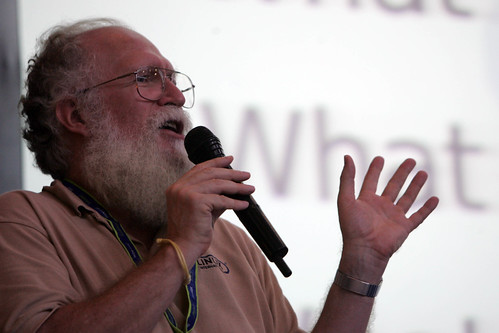Xwiki, a French company aimed to bring open source wiki to the enterprise, recently won the i-Expo Prize for Economic Intelligence at the i-Expo 2007 show in Paris for XWiki Watch.
 Ludovic Dubost by rsepulveda
Ludovic Dubost by rsepulveda
I happened to know about Xwiki few moths ago reading that at ENST were having two internship proposals to work on XWiki, later I got in touch with Luis Arias and since then we occasionally exchange opinions and ideas about Open Source business models.
Yesterday I had a conversation with Ludovic Dubost, Xwiki CEO, and we start speaking about how Wikis in general are getting more an more interest and attention, despite Knowledge Management and Collaboration tools are not on the food chain.
Then I asked Ludovic about XWiki Watch.
XWiki Watch concerns an activity which is well defined in the enterprise. monitoring what competitors do, how your company is perceived, how much press is received.. The concept is not new, it’s just Internet opened new opportunities.
I mean, the Wiki is already perceived as a way to record knowledge about the competition, but only manually before XWiki Watch.
Why should I use Xwiki Watch?
With XWiki Watch you can mix retrieving info from the Internet, flag it, comment it but also write your own info, create wiki pages about the subjects you are watching and you can construct a knowledge base (wiki style) which will the connected to the internet info
We are also planning to have delivery as a web site or in a blog, in addition to the delivery as mail, pdf, and RSS feed.
The big differentiator versus RSS aggregators is the delivery tools, while the big differentiator versus existing Competitive intelligence tools is the collaborative aspects (flags/comments) and the Wiki integration.
In XWiki Watch once the different users select the best news and comment them, and tags them, once you have done this you can construct a filter and ask for a specific delivery. So the filter could specify that you want only the flagged articles and specifying that you want them by email, or PDF, or on a web page, or a news RSS feed.
Actually XWiki Watch doesn’t collect news from source that are not RSS enables, as tools like MySyndicaat (actually not Open Source but a great tool to do newsmastering), but they eventually could do some custom coding. After all their business model is a mix of Products specialists and Split OSS/commercial Product. FLOSSMETRICS taxonomy describes Product specialists companies that created (or maintains) a software project, and use a pure FLOSS license to distribute it, and the main revenues come from services like training and consulting. But XWiki it is also adopting the Split OSS/Commercial product business model, selling XWiki Enterprise edition, and I guess they will soon expand their offer in this respect.
Can you tell me why Xwiki Watch won the prize?
We were in a conference about Competitive Intelligence, and XWiki Watch won the innovation prize. The main reason for the prize was because of the ability for XWiki Watch to “democratize” Competitive intelligence. As a matter of most organization tend hire a person to do that and deliver info to the management or to the company, with XWiki Watch you can decide to organize things differently, like everybody in the company becomes a Watcher and everybody gets the most interesting info delivered. While actually if you look at it precisely you’ll see that everybody is doing watching on his space, it’s just not shared.
While firms like Wikispaces are mainly working with on-line collaboration and open source industries, XWiki apparently is differentiating its offer going further than the wiki, targeting collaborative tools, project management and collaborative watching. In order to do that they are through partnerships with other players, like Nearbee, CHRONOPOLYS.
Thank you Ludovic, and happy hacking!
About XWiki.
XWiki is an open source Wiki, and it is also an Enterprise wiki which allows the creation of applications within the Wiki interface. The languages that can be used are Velocity and Groovy, it is written in Java and it uses database like MySql or HSQLDB.
Technorati Tags: XWiki, Xwiki Watch, LudovicDubost, Business models
 Steve Raby
Steve Raby
 Jon Hall Maddog by
Jon Hall Maddog by 


 Sold! by
Sold! by  Game of Life by
Game of Life by  Ludovic Dubost by
Ludovic Dubost by
Reply